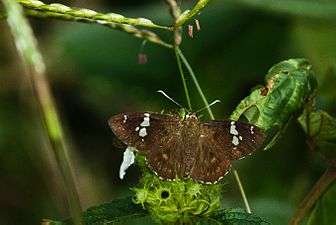Celaenorrhinus ruficornis
Celaenorrhinus ruficornis,[2][3] the Tamil spotted flat,[4] is a butterfly belonging to the family Hesperiidae which is found in India and Java.[5][6][7][8]
| Tamil spotted flat | |
|---|---|
 | |
| Scientific classification | |
| Kingdom: | |
| Phylum: | |
| Class: | |
| Order: | |
| Family: | |
| Genus: | |
| Species: | C. ruficornis |
| Binomial name | |
| Celaenorrhinus ruficornis (Mabille, 1878)[1] | |
| Synonyms | |
| |
Range
The subspecies, Celaenorrhinus ruficornis fusca Hampson, 1889[9] occurs in India in the Western Ghats, Nilgiris and the Palni hills.[5][3][4][10]
Description
The butterfly has a wingspan of 45 to 50 mm. The butterflies resemble the common spotted flat except that the discal spot in 2 and the spot end cell of the forewing are separate. The upper hindwing is only obscurely marked. The antenna is chequered and has a white club.[11]
Male. Upperside dark olive-brown, but not blackish as in Celaenorrhinus spilothyrus the brownish-oehreous setae on the basal area of the forewing and the hairs of the hindwing more ochreous. Forewing with the sub-apical spots and the spots of the discal band similarly disposed, but there is usually only one lower dot of the suli-apical series, and the lowest small spot of the discal series is almost always wanting in this sex; the uppermost spot of the discal series is always white, not ochreous as in C. spilothyrus. Hindwing without markings. Cilia of both wings alternately black and white, the alternations more pronounced on the hindwing than on the forewing, in C. spilothyrus it is entirely blackish on both wings. Underside as on the upperside, the entire surface of both wings covered with minute ochreous-grey scales. Antennpe on the underside, with all the club, except its tip, and the upper third of the shaft pure white, the remainder of the shaft with pure white dots; palpi with the inner half ochreous-grey marked with black, the outer half blackish, white at the sides and below the eyes; head, body above and below and the legs concolorous with the wings. Female like the male above and below, but the spots in the forewing are larger, the discal band consequently more continuous, the outer spot usually wedged into the junction of the two large sub-quadrate spots, there is also on the underside of the hindwing an obscure whitish dot at the end of the cell. Cilia of both wings as in the male.
Habits
It is common along the Western Ghats, especially during the monsoon. It may be caught in the daytime by beating out roadside patches of Lantana camara.[11]
Life history
Food plants: Phaulopsis, Strobilanthes (Acanthaceae).[12]
Cited references
- Beccaloni, G.; Scoble, M.; Kitching, I.; Simonsen, T.; Robinson, G.; Pitkin, B.; Hine, A.; Lyal, C., eds. (2003). "Celaenorrhinus ruficornis". The Global Lepidoptera Names Index. Natural History Museum. Retrieved April 19, 2018.
- Mabille, Paul (1878). Annales de la Société entomologique de Belgique. Bruxelles: Société entomologique de Belgique. pp. 32–33.
- Markku Savela's website on Lepidoptera Page on genus Celaenorrhinus., Subfamily Pyrginae, Family Hesperiidae
- Evans, W.H. (1932). The Identification of Indian Butterflies (2nd ed.). Mumbai, India: Bombay Natural History Society. p. 327, ser no I11.20.
- R.K., Varshney; Smetacek, Peter (2015). A Synoptic Catalogue of the Butterflies of India. New Delhi: Butterfly Research Centre, Bhimtal & Indinov Publishing, New Delhi. p. 37. doi:10.13140/RG.2.1.3966.2164. ISBN 978-81-929826-4-9.
- E. Y., Watson (1891). Hesperiidae Indicae : being a reprint of descriptions of the Hesperiidae of India, Burma, and Ceylon. Madras: Vest and Company. p. 141.
- W. H., Evans (1949). A Catalogue of the Hesperiidae from Europe, Asia, and Australia in the British Museum. London: British Museum (Natural History). Department of Entomology. p. 102.
-

- Hampson, G. F. (1888). Journal of the Asiatic Society of Bengal: Butterflies of the Nilgiri District. Calcutta: Asiatic Society of Bengal. p. 367.
- Evans (1932) gives range of C.r. area Plotz as South India to Bengal; C. r. ruficornis, Mabille as Java and C. r. celebica Evans, 1932 as Sulawesi. Reorganisation of the species appears to have led to restriction of the range of the species.
- Wynter-Blyth, Mark Alexander (1957). Butterflies of the Indian Region. Bombay, India: Bombay Natural History Society. pp. 460–461. ISBN 978-8170192329.
- As per Igarashi & Fukuda (2000) which provide illustrations of food plant, larva and pupa vide this site.
See also
References
- Evans, W.H. (1932). The Identification of Indian Butterflies (2nd ed.). Mumbai, India: Bombay Natural History Society.
- Kunte, Krushnamegh (2000). Butterflies of Peninsular India. India, A Lifescape. Hyderabad, India: Universities Press. ISBN 978-8173713545.
- Wynter-Blyth, Mark Alexander (1957). Butterflies of the Indian Region. Bombay, India: Bombay Natural History Society. ISBN 978-8170192329.
Online
- Beccaloni, George; Scoble, Malcolm; Kitching, Ian; Simonsen, Thomas; Robinson, Gaden; Pitkin, Brian; Hine, Adrian; Lyal, Chris. "The Global Lepidoptera Names Index (LepIndex)". Natural History Museum, London. Retrieved 2016-10-15.
- Brower, Andrew V. Z., (2007). Celaenorrhinus Hübner 1819. Ancistrocampta C. Felder & R. Felder 1862 currently viewed as a subjective junior synonym. Version 4 March 2007 (under construction). http://tolweb.org/Celaenorrhinus/95353/2007.03.04 in The Tree of Life Web Project, http://tolweb.org/.
- "Markku Savela's website on Lepidoptera".